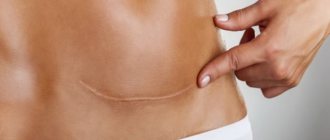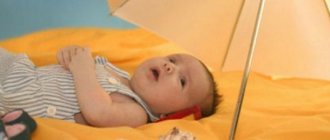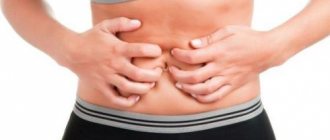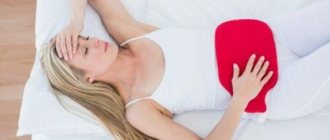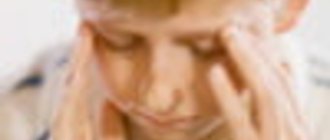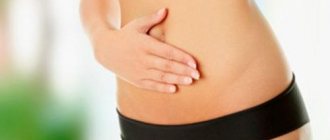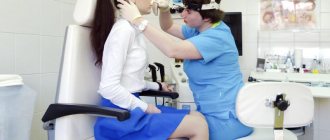- Abdominal pain in babies
- Abdominal pain in preschoolers
- Abdominal pain in schoolchildren
- First aid for abdominal pain
Abdominal pain in young children is often the first symptom of any onset of illness, since pain associated with almost all organs is concentrated in the solar plexus area.
In most cases, a child’s stomach hurts due to indigestion, because he has eaten too much. But, despite the seeming frivolity of such complaints, they can be very dangerous and require emergency medical intervention.
Abdominal pain in babies
Newborn babies often suffer from colic caused by errors in maternal nutrition or changes in weather. The true cause of these infant pains lies in the unstable functioning of the baby’s digestive system and adaptation to new living conditions. By two months, the situation in most families has stabilized; the child no longer cries from colic as often as before.
Congenital pathologies of the digestive system, for example, gallbladder dyskinesia, can cause pain in newborns and preschoolers. The child not only experiences pain, but also develops diarrhea. Treatment is prescribed by the pediatrician after examining the baby.
A symptom of intussusception, which mainly occurs in infants between four and nine months, is acute pain in the child's abdomen, which is expressed in the child's sudden restlessness, crying and reluctance to eat. After some time, the attack stops just as abruptly, but then resumes again, and then the baby’s condition becomes very serious. Vomiting appears, blood instead of feces during bowel movements, vomit with a fecal odor. Hospitalization is required - call an ambulance at the first sign!
Intestinal volvulus and gastric volvulus also occur mainly in newborns. Characterized by acute abdominal pain, vomiting, intestinal motor function is practically absent, as is stool. The child is tossing about, the tummy is swollen asymmetrically. Treatment is surgical, be sure to call an ambulance.
Constipation in an infant causes abdominal pain and inability to go to the potty for more than three days; this condition often occurs after a high fever. The child’s anxiety can be eliminated by giving him an enema, after which the intestines are released in the form of copious stools and the baby calms down.
Headache in children and sleep disorders
A person cannot live without rest. The lack of adequate sleep has a particularly negative impact on a child, whose intellectual and physical abilities decrease and school performance worsens with the slightest lack of sleep. With chronic insomnia in children, other problems may arise, for example, frequent infectious diseases, depressive disorders.
Headache in children can cause sleep disturbances, especially insomnia. Prescribing sleeping pills in such situations will not solve the problem in any way, and may even worsen the condition. In addition, many sleeping pills are simply contraindicated for children, especially for those who have not yet reached the age of 12.
At the Rehabilitation Clinic in Khamovniki there is a Sleep Medicine Center, where insomnia is diagnosed and treated. If you suspect that the reason for your child's poor sleep lies in a headache, you can take him to the sleep department. The child will be prescribed all the necessary examinations, given recommendations for treatment, and, if necessary, referred to a specialized institution that deals exclusively with children's problems. Sign up for a consultation by phone: +7.
Abdominal pain in preschoolers
The most common cause of abdominal pain in preschool children is gastritis, which occurs when the stomach is full or when the child eats rough food. The disease can be triggered by prolonged stress or a viral infection. Gastritis manifests itself as pain in the stomach, that is, in the upper abdomen, which accompanies the symptoms:
- bloating;
- loss of appetite;
- nausea.
Treatment consists of following a diet, taking enzyme preparations and herbal medicine. Of the plants that have the most beneficial effect on the gastric mucosa, we can name plantain in fresh or dried form. In pharmacies there is a freeze-dried extract from plantain called “Plantaglucid”.
Intestinal infections cause the most irritating consequences:
- cramping abdominal pain;
- diarrhea;
- nausea;
- vomiting;
- temperature increase;
- weakness.
The pain is most often localized in the upper abdomen, but in older children pain can be observed in the intestines. This group of infections is treated only with antibacterial drugs prescribed by a doctor.
Appendicitis is such a serious cause of acute abdominal pain that children suspected of having it are immediately hospitalized in the surgical department of the hospital. There are acute and catarrhal appendicitis; both are characterized by dull, aching pain in the right lower lobe of the abdomen. At the very beginning of the development of the disease, the child may feel slight nausea, weakness and a slight rise in temperature. After some time, the pain becomes acute, unbearable, the baby cannot move, the abdominal muscles are tense. All these symptoms serve as an indication for emergency, immediate surgery that does not pose a threat to the child’s health.
Worms are also the culprits of abdominal pain in a child of any age, as they cause intestinal obstruction and inflammation of the appendix. The pain is paroxysmal, there may be diarrhea and vomiting, as well as a deterioration in the baby’s general well-being. Treatment consists of eliminating intestinal obstruction and taking medications that destroy parasites.
Inflammation of the lungs causes acute pain in the abdomen when breathing, and the more often the baby breathes, the more painful it is. Pneumonia can masquerade as acute appendicitis, therefore, if such a pathology is suspected, an x-ray examination must be performed. Treatment for pneumonia is always long-term, in a hospital setting, and the recovery period is quite long.
Acute bronchitis, tracheitis and especially whooping cough, which causes a debilitating cough, can cause abdominal pain the day after the attack when laughing, coughing and any physical stress. This is not dangerous, because the pain is muscle and does not require treatment.
How is diagnosis carried out?
To diagnose pathologies associated with the gastrointestinal tract, consultation with a specialist - a gastroenterologist is necessary. First, the doctor will collect anamnesis and conduct an examination. Depending on the time of onset of pain and the location of its localization, a specialist can guess what kind of disease it is. Thus, pain while eating is characteristic of esophagitis (inflammation of the esophageal mucosa). If after eating the pain decreases, but after a while it returns, a possible diagnosis is gastroduodenitis (inflammation of the gastric mucosa, spreading to the duodenum). Acute pain in the navel area, regardless of food intake, may indicate pathologies such as umbilical hernia, damage to the small intestine, abdominal lymph nodes (mesadenitis). And pain in the upper abdomen is characteristic of gastritis, gastroduodenitis, pancreatitis.
To confirm the diagnosis, the gastroenterologist will prescribe the necessary tests: blood test, urine test, biochemical blood test, laboratory test of stool (bacterial culture, scatology, enterobiasis, protozoa), as well as ultrasound and, if necessary, endoscopic examination. Only after a complete examination can a doctor make a final diagnosis and prescribe effective treatment.
Abdominal pain in schoolchildren
Almost all children experience abdominal pain after a long run, as well as abdominal muscle pain the next day after intense exercise. This is absolutely normal and does not require medical intervention.
Girls with the onset of their menstrual cycle may feel severe nagging pain in the lower abdomen in the first days of menstruation, most often after sitting at a desk for a long time at school. This symptom indicates physiological features of the structure and location of the uterus, such as curvature. A distinctive feature of such pain is its sudden cessation after a few minutes of walking. No treatment is required, but for painful periods, consultation with a gynecologist is required.
Children of primary school age and adolescents, prone to hysteria and highly emotional, often worry parents and doctors with attacks of acute or muted abdominal pain. Especially often they occur before the start of unpleasant events for the child - a test at school or classes with a tutor. But this is not fiction, children actually experience pain, nausea, they may vomit or have diarrhea. Psychosomatic diseases are a child’s response to too high stress; most often this affects children with a delicate nervous system and prone to self-hypnosis. Treatment in this case is only symptomatic; consultation with a psychologist or psychiatrist is required.
Hepatitis is a serious disease in which the liver becomes inflamed and enlarges, stretching the capsule in which it is located, thereby causing a dull, aching pain in the right hypochondrium. In addition, symptoms of hepatitis may include:
- rash;
- temperature increase;
- nausea;
- vomit.
Treatment is always inpatient, since hepatitis is transmitted mainly by contact, with the exception of some forms transmitted through blood.
Girdle pain that radiates to the back and is long-lasting, with loss of appetite, vomiting and nausea, and signs of intoxication are characteristic of acute pancreatitis. This is an inflammation of the pancreas, which is most often caused by a complication after an infectious or viral disease. With pancreatitis, children lie on their left side, trying not to move, as this aggravates the pain. The pediatrician prescribes treatment depending on the stage of the disease; surgical intervention is also possible.
Pain spread throughout the abdomen, radiating to the back or groin, can occur in children with any urological syndrome. So, with acute pyelonephritis, the pain is not strong, dull, there is a feeling of discomfort, the child tries to take a more comfortable position. Acute pyelonephritis is always accompanied by high fever.
Renal colic due to kidney prolapse or kidney stones causes the most severe and unbearable pain, comparable only to the pain of appendicitis. The child's abdomen is very tense, there may be signs of bloating, nausea and vomiting, and chills may occur. In case of renal colic, children must be taken to the urology department.
Abdominal injuries can be very dangerous for a child, as they can lead to rupture of internal organs. A child’s complaints of abdominal pain after a fall from a height or a fight, not to mention a car accident, should definitely alert parents. A visit to the hospital for such complaints is necessary in any case, especially if the child feels worse and worse. Internal bleeding is extremely dangerous for children.
Features of treatment
As a rule, treatment for pain in the legs includes several conservative methods. Surgery is required only in cases of severe destruction of musculoskeletal tissue or accumulation of pus, as well as in certain heart pathologies. In the early stages of leg disease are treated with:
- drug therapy;
- exercise therapy;
- physiotherapy;
- massage;
- reflexology (acupuncture, biopuncture).
Complex therapy allows you to eliminate inflammatory processes and get rid of pain, normalize blood circulation, improve tissue nutrition, strengthen muscles and ligaments and provide conditions for healthy, harmonious development of the body. With timely help, even dangerous diseases, such as infectious arthritis, can be successfully treated without long-term consequences for the body. In the network of clinics “Hello!” There are all possibilities for early and accurate diagnosis of diseases that cause pain in the legs. Experienced and attentive medical staff create comfortable treatment conditions, and the development of an individual treatment plan for each patient eliminates the risk of complications.
First aid for abdominal pain
Parents who experience abdominal pain in a child, especially if it is acute and aggravated by other warning symptoms, should first call an ambulance. The child needs to be put to bed and not given any painkillers until the doctor arrives, as this can smooth out or distort the picture of the disease. Self-treatment of acute pain with antibiotics is unacceptable, since the cause of the disease may be completely different.
The importance of seeing a doctor in the first hours of pain is that if the situation requires emergency surgical intervention, for example, with a strangulated hernia or acute appendicitis, then delay will lead to tragic consequences for the health, and perhaps the life of the child. Newborns and adolescents are especially dangerous in this regard. The clinical picture of the disease in infants often suffers from the absence of reliable symptoms or their smoothness, and adolescents tend to hush up the manifestations of pain, fearing medical intervention and the collapse of their plans.
If you consult a doctor in a timely manner, the prognosis even for serious diseases accompanied by abdominal pain is favorable.
What to do if your child’s legs hurt?
Self-administration of antibiotics and painkillers can only harm health: cause the development of secondary diseases or accelerate the progression of the underlying pathology. In case of intense or persistent pain, you should consult a pediatrician or orthopedist. A comprehensive diagnosis will help answer the question of why a child’s legs hurt:
- X-ray;
- MRI;
- CT;
- ECG;
- blood and urine tests;
- collection of intra-articular fluid (in some cases).
Please note: radiography makes it possible to detect only deformation of the joints and spine, but does not provide information about the condition of the spinal cord, nerve endings and blood vessels. Therefore, do not refuse if your doctor recommends tests such as MRI and CT: they will help to accurately determine the cause of the pain.
Non-arthritic causes of pain
Meniscal pain – usually occurs after an injury and affects one joint. Most often appear in children 10-12 years old. They are disturbing under loads, concentrated in the projection of the joint gap where the meniscus is damaged.
Osteochondral - affect one joint, most often on the leg, occur in children 8-10 years old. The mechanism for the development of such pain may be improper physical activity. However, the exact reason is unknown. The pain occurs with exertion and is limited to one joint.
Pain in the patellas , in addition to osteochondropathy and pathological dislocations, can occur with high position of the patellas, chondromalacia, and mediopatellar fold syndrome.
Stress pain in the feet - their causes can be: a number of bone associations, congenital malformations of the feet, joint stiffness syndrome against the background of systemic skeletal pathologies.
Tendon-muscular and enthesitis - variants of chronic and acute pathology (post-traumatic, transient, etc.). Primary enthesopathy is a symptom of SEA syndrome or juvenile arthritis. Secondary occurs against the background of an underlying orthopedic disease.
Joint syndrome – pain varies in variation and severity, usually affecting the hip, ankle, and knee joints. Less commonly – elbows and shoulders. Such pain is accompanied by inflammation. The pain is limited to one joint and the tendon-muscular element or the area where the tendon attaches to the bone.
Pain due to hypermobility affects preschoolers and primary schoolchildren. They can be symmetrical, have a diffuse nature, and are localized on the anterior surface of the legs. In some cases, the ankle and knee joint are affected. Most often these are night and evening pains, which are preceded by exercise. This pain syndrome is myalgia as a consequence of overstrain of the muscles of the legs with a weak capsular-ligamentous element. Many literature sources call this condition “growing pains . Parents should be wary of their child's night pain, because it may be associated with a tumor, especially against the background of fever and profuse sweating.
At an older age, pain due to hypermobility is not detailed and has a diffuse nature. May affect one joint or several. They occur both during and after load (during the day and evening). Such pain appears due to microtrauma of the structures inside the joint, excessive tension of the patellofemoral joint, and stretching of the ligamentous-capsular element.
Relationship between growing pains and child nutrition
Deficiency of microelements and vitamins can provoke and intensify growing pains. To prevent seasonal hypovitaminosis, the child should take pharmaceutical preparations containing the required quantities of minerals and vitamins twice a year (in spring and autumn). The intake of multivitamin complexes must be previously agreed with the pediatrician.
It is important to maintain a drinking regime - a child’s body needs clean drinking water every day.
The diet in childhood should be varied and contain all the nutrients important for the harmonious growth and development of children. The menu should include meat, fish and vegetable dishes, various fruits and berries. It is necessary to limit the content of carbohydrates in the diet (baked goods, sugar, confectionery), exclude coffee and sweet carbonated drinks.

